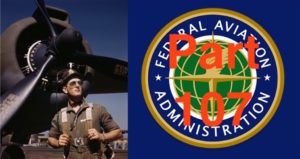 Do you need a Part 107 certificate? While Part 107 does make it easier to operate a drone commercially, not everyone will have to take the test. Here’s the summary of the FAA rules (with all the links and references) about who should start studying – and who can put the books down and go fly a drone.
Do you need a Part 107 certificate? While Part 107 does make it easier to operate a drone commercially, not everyone will have to take the test. Here’s the summary of the FAA rules (with all the links and references) about who should start studying – and who can put the books down and go fly a drone.
Commercial Drones Only
The Small UAS Rule is very clear – if you fly for fun or recreation, you do not need a Part 107 Certificate (an airman’s certificate with UAS rating.) There is no test to fly your drone recreationally; you just need to know the basic rules and fly safely. (Need help with those? Visit knowbeforeyoufly.org for the details, or check out the KnowBeforeYouFly app.)
If you’re unclear about whether your use is recreational – you’re just taking pictures – or commercial, it all comes down to whether or not money changes hands. According to the Knowbeforeyoufly.org website – a collaboration between the FAA and industry:
The recreational use of sUAS is the operation of an unmanned aircraft for personal interests and enjoyment. For example, using a sUAS to take photographs for your own personal use would be considered recreational; using the same device to take photographs or videos for compensation or sale to another individual would be considered a commercial operation. You should check with the FAA for further determination as to what constitutes commercial or other non-hobby, non-recreational sUAS operations.
Keep in mind that while you don’t need a Part 107 certificate to fly recreationally, you may need to register and label your drone with the FAA. Drones that weigh more than .55 pounds and less than 55 pounds can be registered online; drones that weigh more than 55 pounds must be registered with the FAA through a different process. If you aren’t sure if your small hobby drone needs to be registered, check out this list from the FAA for examples and specific models.
If you are a commercial drone operator and think you might need to take the Part 107 test, read on.
Current Pilots
Pilots who already have a current Part 61 Airman’s Certificate for manned aircraft and have completed a flight review within the last 2 years can use a simplified process for commercial drone certification – they do not need to take the same Part 107 test as non-pilots.
Existing pilots will need to take the FAA’s online training course, “Part 107 small Unmanned Aircraft Systems (sUAS) ALC-451;” complete an application, FAA Form 8710-13 (FAA Airman Certificate and/or Rating Application for a remote pilot certificate); and present the test report, form, proof of current flight review and valid ID in person to the appropriate FAA certified representative. (You can find all of the details and links on the FAA’s website here.)
Public Drones
If you work for a federal, state or local government office and want to operate a drone as part of your responsibilities, you may not need a Part 107 certificate. Government drone operators may be eligible to apply for a public Certificate of Waiver or Authorization (COA) for certain operations.
New Commercial Drone Pilots
If you are planning to operate a drone commercially, do not work for a government agency, and you do not already have a Part 61 Airman’s Certificate, then you probably need to take a Part 107 Certificate test.
A Part 107 Certificate without a waiver will cover commercial drone operations under the following conditions:
- The drone will operate in Class G airspace
- Must keep the aircraft in sight (visual line-of-sight)
- Must fly under 400 feet
- Must fly during the day
- Must fly at or below 100 mph
- Must yield right of way to manned aircraft
- Must NOT fly over people
- Must NOT fly from a moving vehicle
To operate outside of those conditions, drone operators will need a waiver from the FAA.
Bonus: What About Drone Delivery?
Drone delivery is allowed – but drone flight over people or beyond visual line of sight is not. If you can operate a drone delivery service under those circumstances, you may have a goldmine business opportunity!
One more thing: Part 107 is the Small UAS Rule – if the drone you plan to use weighs more than 55 pounds, you will need to contact the FAA about the correct procedure to obtain certification.
Now What?
The first step to getting your Part 107 Certificate is to schedule an appointment to take your Aeronautical Knowledge Test at an FAA certified Knowledge Testing Center – find the one closest to you here. You’ll be able to take the test after Part 107 becomes active, on August 29. Then study! The FAA estimates that it will require 20 hours of study to pass the test – but they also say that they expect 90% of applicants to pass. When you’ve passed the test, you’ll have to fill out an application and undergo a TSA background check before the FAA processes your certificate.
For further details on studying for the test and obtaining your Part 107 Certificate, visit the FAA website pages and links here.
Source link
 Unmanned Aerial Vehicle The latest drone news
Unmanned Aerial Vehicle The latest drone news



